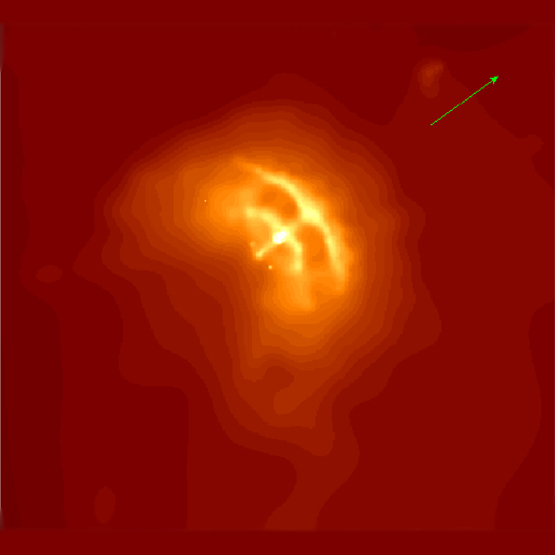
 Credit: Vela Image - NASA/CXC/PSU/G.Pavlov et al.
Credit: Vela Image - NASA/CXC/PSU/G.Pavlov et al.
Affinity of X-ray Pulsars
X-ray pulsars are thought to be neutron stars, extremely dense remains of
the core of a massive star. X-ray pulsars spin very rapidly (rotating tens
or hundreds of times per second) and possess very strong magnetic fields.
Jets of energetic particles shoot out of the magnetic poles and the pulsars
are surrounded by large clouds of hot ionized gas. The image on the left
shows a new image of the Vela pulsar
obtained by the Chandra X-ray
observatory. The pulsar is located at the bright spot at the center of the
image; the bright jet can be seen emanating diagonally from the pulsar; and
rings of X-ray emission from high energy particles produced by the central
neutron star can be seen to the upper right of the pulsar. Surprisingly
the jet points in the direction of the motion of the pulsar (shown as the
green arrow in the righthand corner), which suggests that the jet at the
bottom left actually accelerates the pulsar through space like a rocket
engine. The Chandra image of another X-ray pulsar, the Crab
pulsar, is remarkably similar to the Vela image: the Crab also
possesses jets along with swirling clouds of hot gas further from the
pulsar. In fact the similarity in X-ray morphology between the 2 X-ray
pulsars is truly startling, as can be seen in this movie
(in Quicktime format), in
which the scaled image of the Crab (in blue) is gradually overlaid on the
image of the Vela pulsar.
Last Week *
HEA Dictionary * Archive
* Search HEAPOW
* Education
Each week the HEASARC
brings you new, exciting and beautiful images from X-ray and Gamma ray
astronomy. Check back each week and be sure to check out the HEAPOW archive!
Page Author: Dr. Michael F.
Corcoran
Last modified June 18, 2000


